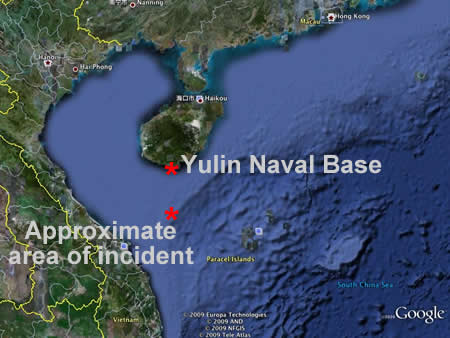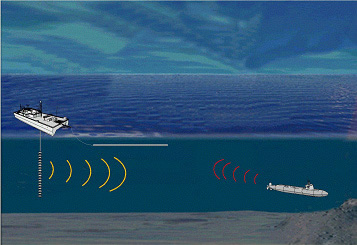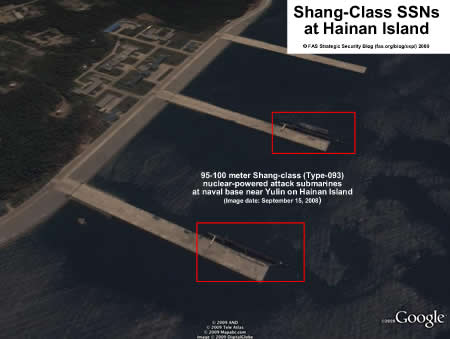US-Chinese Anti-Submarine Cat and Mouse Game in South China Sea
 |
| The Chinese military harassment of a U.S. submarine surveillance vessel Sunday occurred only 75 miles from China’s growing naval base near Yulin on Hainan Island. |
.
By Hans M. Kristensen [updated 1:50 P.M., 3/10/09]
The incident that unfolded in the South China Sea Sunday, where the U.S. Navy says five Chinese ships harassed the U.S. submarine surveillance vessel USNS Impeccable, appears to be part of a wider and dangerous cat and mouse game between U.S. and Chinese submarines and their hunters.
News media reports cite Pentagon reports of half a dozen other incidents just within the past week in which U.S. surveillance vessels were “subjected to aggressive behavior, including dozens of fly-bys by Chinese Y-12 maritime surveillance aircraft.”
The latest incident allegedly occurred in international waters only 75 miles south of a budding naval base near Yulin on Hainan Island from where China has started operating new nuclear attack and ballistic missile submarines. The U.S. Navy on its part is busy collecting data on the submarines and seafloor to improve its ability to detect the submarines in peacetime and more efficiently hunt them in case of war.
|
USNS Impeccable (T-AGOS-23) |
 |
|
The USNS Impeccable was designed specifically as a platform for the SURTASS towed array and its Low Frequency Array upgrade. |
An Impeccable “Civilian Crew”
The U.S. Navy’s description of the incident states that “a civilian crew mans the ship, which operates under the auspices of the Military Sealift Command.” Yet as one of five ocean surveillance ships, the USNS Impeccable (T-AGOS 23) has the important military mission of using its array of both passive and active low frequency sonar arrays to detect and track submarines. The USNS Impeccable works directly with the Navy’s fleets, and in 2007 operated with the three-carrier strike battle group in Valiant Shield 07 exercise in the Western Pacific.
USNS Impeccable is equipped with the Surveillance Towed Array Sensor System (SURTASS), a passive linear underwater surveillance array attached to a tow cable. SURTASS was developed as a floating submarine detection system for deep waters, and the Navy wants to add an active Low Frequency Array (LFA) to improve long-range detection of submarines in shallow waters.
|
SURTASS LFA Deployment |
 |
| The SURTASS LFA passive-active surveillance system is designed to detect submarines and surface ships at long range in deep and shallow waters. |
.
Indeed, according to the U.S. Navy, the USNS Impeccable is “designed specifically as a platform for the SURTASS towed array and its LFA adjunct.”
New Chinese Nuclear Submarines at Yulin Naval Base
Among Chinese submarines the USNS Impeccable was monitoring is probably the Shang-class (Type-093) nuclear-powered attack submarine, a new class China is building to replace the old Han-class, and which has recently been seen at the Yulin base.
A commercial satellite image taken September 15, 2008, shows two Shang-class submarines present at the base, the first time – to my knowledge – that two Shang-class SSNs have been seen at the base at the same time.
.
An earlier image from February 2008 showed a Jin-class (Type-094) ballistic missile submarine at the Hainan base for the first time. The Jin-class is not visible on the later image. China has been reducing its submarine fleet by replacing old boats with fewer modern ones. The submarines normally stay close to shore, but in 2008 sailed on 12 longer patrols – twice as many as in 2007.
Time For an Incident Agreement
The incident begs the question who or at what level in the Chinese government the harassment in international waters was ordered. The incident will make life harder for those in the Obama administration who want to ease the military pressure on U.S.-Chinese relations, and easier for hardliners to argue their case.
For both countries the Sunday incident and the many other incidents that have occurred recently are reminders that the time is long overdue for an agreement to regulate military operations. Following a break in response to U.S. military sales to Taiwan, U.S.-Chinese mid-level military-to-military talks were scheduled to resume last month, and the Commander of U.S. Pacific Command, Admiral Timothy Keating, said “nascent initiatives” were underway to draw up some “rules of the road” to address some of these issues.
Absent a substantial agreement, building on the 1998 US-Chinese Military Maritime Safety Agreement (which already includes discussions on “interpretation of the Rules of the Nautical Road and avoidance of accidents-at-sea”) and the 1972 US-Russian Incidents at Sea Agreement, incidents like the USNS Impeccable incident will continue as a serious irritant and source of mistrust between China and the United States, a situation neither country nor other nations in the region can afford.
Additional resources: US-Chinese Military Maritime Safety Agreement (1998) | US-Russian Incidents at Sea Agreement (1972) | Secrecy News Blog: U.S., China, and Incidents at Sea
Satellite imagery has long served as a tool for observing on-the-ground activity worldwide, and offers especially valuable insights into the operation, development, and physical features related to nuclear technology.
This report outlines a framework relying on “Cooperative Technical Means” for effective arms control verification based on remote sensing, avoiding on-site inspections but maintaining a level of transparency that allows for immediate detection of changes in nuclear posture or a significant build-up above agreed limits.
The grant comes from the Carnegie Corporation of New York (CCNY) to investigate, alongside The British American Security Information Council (BASIC), the associated impact on nuclear stability.
Satellite imagery of RAF Lakenheath reveals new construction of a security perimeter around ten protective aircraft shelters in the designated nuclear area, the latest measure in a series of upgrades as the base prepares for the ability to store U.S. nuclear weapons.
